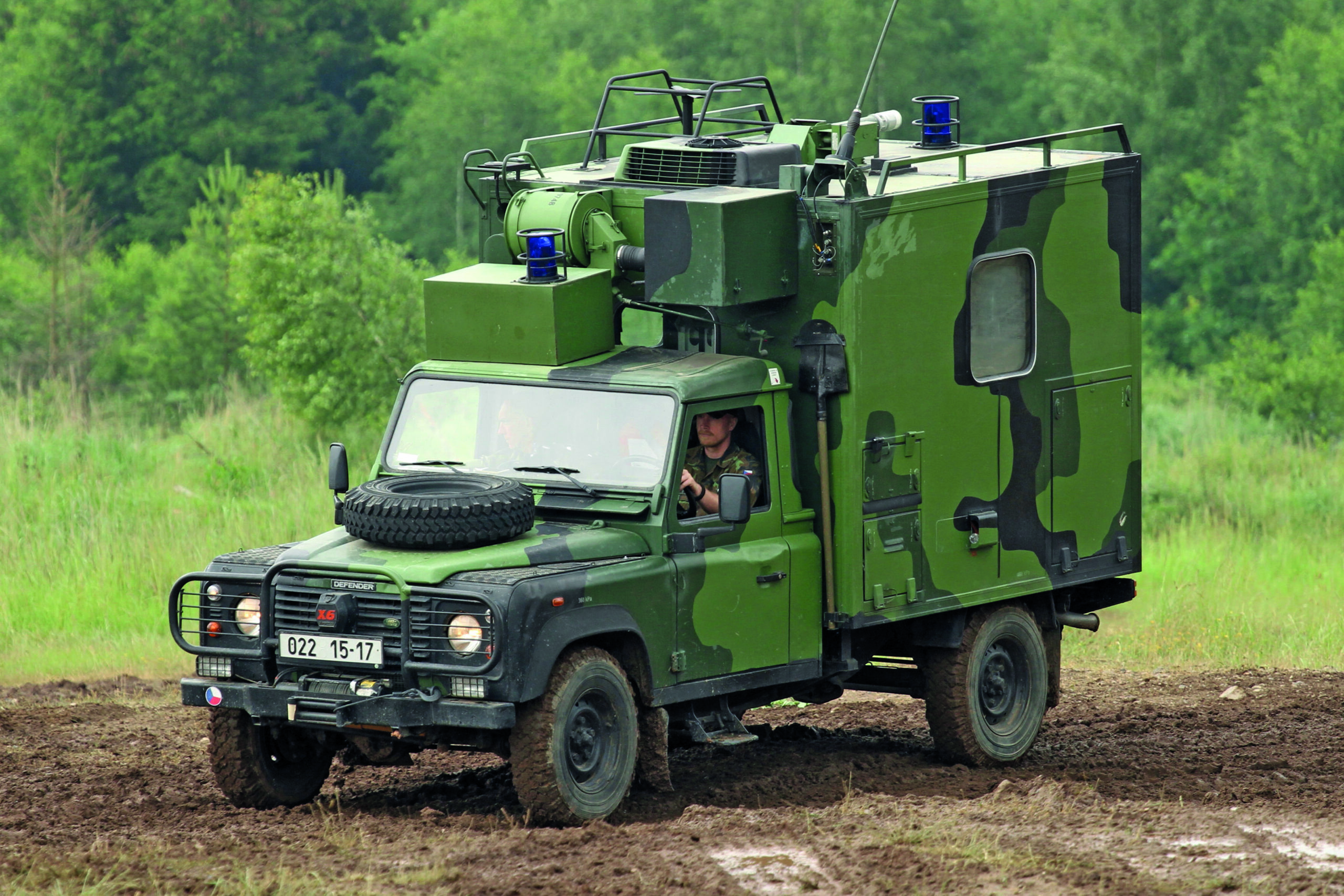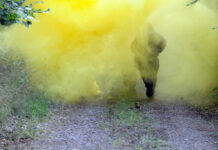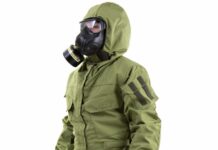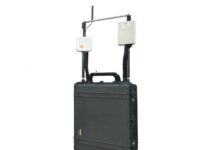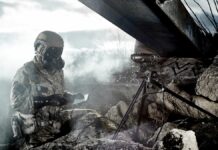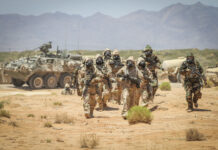Some commenters have predicted the demise of the chemical, biological, radiological, and nuclear (CBRN) reconnaissance vehicle for about 15 years. Reports of the end of the CBRN recce vehicle are premature, but an astute observer can see why its lifespan may be short.
Conceptually, the entire existence of CBRN reconnaissance vehicles is under challenge on several fronts. The first of these is based on economics and logistics. Even the largest army will only have scope for so many CBRN recce vehicles. Overall, European armies are much smaller in size than in previous decades and have far fewer combat vehicles. CBRN vehicles will only ever be a small percentage of an overall inventory. Having a vehicle platform that is different from the rest of your fleet of combat vehicles makes training and maintenance more complex. The Rheinmetall FUCHS wheeled APC as a CBRN recce vehicle made sense in the 1980s Bundeswehr, where the FUCHS was commonplace for general use. FUCHS made a lot less sense, logistically, in the US Army, where it was a standalone end item (called the “FOX” to protect sensibilities) that baffled much of the rest of the Army. For these reasons, many CBRN recce vehicles these days tend to be extensions of existing product lines.
Technological Challenges
Technology also challenges the concept of the CBRN recce vehicle. The very concept of CBRN recce vehicles dates from 1960s and 1970s Cold War era doctrine. At the beginning of this author’s military career in the late 1980s, chemical detection equipment was in its relative infancy. It was expensive, difficult to use, and rare. Biological detection was non-existent. A number of technical advances have made radiation detection equipment somewhat cheaper and better, but there has been a series of revolutions in chemical detection equipment (as discussed in previous issues of this publication). An infantryman can literally carry more C and R detection than the best CBRN recce vehicle of 1985, for a small fraction of the size and expense – and power it with AA batteries.
The advances in detection technology raise certain questions. Why make a speciality CBRN vehicle when soldiers with handheld equipment can operate out of any vehicle? If you can mount high quality detection equipment on every combat vehicle, isn’t every tank and APC now a CBRN recce vehicle? Both the proponents of and manufacturers of CBRN recce vehicles are sometimes hard-pressed to come up with a reasonable answer to either question.
CBRN Recce Doctrine
The third challenge that conceptually confronts the CBRN recce vehicle is doctrinal. What is it that you expect a CBRN recce vehicle to do? CBRN recce doctrine varies somewhat from country to country, but for the most part, CBRN recce vehicles and teams are expected to perform a fairly basic set of missions. These missions usually include area surveys to confirm and map out the extent of contamination after a suspected CBRN attack, sampling of materials to identify unknown hazards, surveillance to provide warning to the main body of forces, and route reconnaissance to see if an axis of advance or a transportation route is free of contamination. Technology has spent much of the last 50 years actually catching up to the doctrine to do these missions. Further, it is a well-known axiom in professional CBRN defence circles that none of these missions is actually easy.
Many notional CBRN recce scenarios involve either placing CBRN recce vehicles and soldiers in highly vulnerable positions and/or sacrificing their recce capability quite early in an operational scenario due to the vehicles becoming quickly contaminated. The latter is easily demonstrated by route reconnaissance – a clean route is easily cleared but the minute a CBRN recce vehicle drives over persistent contamination the vehicle usually becomes contaminated itself as tracks or tyres become covered in hazardous materials and it cannot do any more recce missions until it gets decontaminated. Some of the doctrine this author never thought made any sense when he was a Chemical Corps lieutenant still does not make any sense 30 years later. Sitting in a command post and looking at divisional and corps level operations, many “traditional” CBRN recce missions are nearly suicidal for lightly armed and armoured troops. The actual utility of specialty recce vehicles for such missions is unknown. Since the advent of specialty CBRN recce vehicles, the armies which have them have not had to defend against widespread chemical weapons threats, so the overall concept remains untested in practice.
The Market
All of these conceptual problems aside, there clearly is a market for CBRN recce vehicles. If there was no market, there would be little need for this article. Military doctrine still calls for CBRN surveys. However, the market has moved relatively little since the most recent market overview in this magazine in issue 02/2021 of this publication. The same programmes and manufacturers dominate the space.
By far the most robust and interesting programme in this field is the M1135 STRYKER Nuclear, Biological, and Chemical Reconnaissance Vehicle (NBCRV). This is a CBRN recce version of the STRYKER now widely fielded in the US Army. If one were to develop a notional archetype of a CBRN recce vehicle, this is the example to follow. The M1135 is made by General Dynamics Land Systems as part of the large fleet of STRYKER variants that are now commonplace as armoured vehicles in the US Army, thus addressing many of the logistical and maintenance concerns posed by a specialty vehicle. The M1135 replaces the M93 FOX, which had been bought as an emergency fill-in during the first Gulf War.
CBRN Recce Vehicles Today
A significant amount of technology resides in an M1135. It includes a mass spectrometer, current generation radiation detection, chemical vapour/gas detection, the JS-LSCAD standoff detector (see issue 01/2018 for a discussion of standoff detection), and one of the first practical field biological sensors. About 300 of these vehicles are in service.
The aforementioned Reinmetall Man (DE) FUCHS CBRN vehicle (originally Daimler Benz), continues in service in many countries. The British Army brought them out of retirement in 2014. Germany, Norway, The Netherlands, Israel, Saudi Arabia, Kuwait, and the UAE have used the FUCHS CBRN recce vehicle and many still remain active or in reserve units. Over 100 units served in the US Army as the M93 FOX until supplanted by the M1135. The FUCHS holds a special place in CBRN recce history, having brought a mobile mass spectrometer, a serious bit of electronic instrumentation, onto the battlefield. As with other categories of detection instrument, mass spectrometers no longer need a vehicle to carry them. Man-portable instruments with better capability than the 1990s-vintage mass spectrometer originally installed in the FUCHS are now widely available. Reinmetall Man continues to market more up to date versions, though.
Other systems continue to appear at defence shows and in marketing literature, with quite variable uptake. Saab’s mobile CBRN recce system, based on their Automated Warning and Reporting mobile system prototype has been around since about 2010. Kuwait has bought Saab systems, possibly to supplement or replace their now ageing FUCHS systems. Finland continues to punch above its weight in this space, with Finnish firms Patria and Environics both touting CBRN recce vehicles. Turkey’s defence industry offers an FNSS “PARS” CBRN recce vehicle on 6×6 and 8×8 APC platforms. Switzerland has a dozen MOWAG (CH) PIRANHA III CBRN vehicles. General Dynamics European Land Systems continues to market a CBRN PIRANHA. The French Véhicule de l’avant blindé (VAB) continues on in a 4×4 CBRN recce version in the French Army’s 2nd Regiment of Dragoons. Developments in this space in Czechia and Slovakia were discussed in the 10/21 issue of this magazine. India and Russia have home-grown CBRN recce vehicles based on Soviet-era APCs. The Italian firm Cristanini produces a “Light Multirole Vehicle” based on IVECO 4×4 vehicles.
Mobile CBRN Laboratories
There is also a market segment for “Mobile CBRN Laboratories.” These are not true recce vehicles in the same way as the systems mentioned above. These systems are not hardened nor are they meant to operate in a live combat environment. Most are not meant to operate on the move. However, they do provide a lot of capability to analyse hazards and some are clearly designed to support the work of dismounted CBRN recce and survey teams. In some countries, with appropriate doctrine, these could serve in CBRN recce-type roles. As a few examples of many, Indra (Spain) and Cristanini (Italy) produce mobile laboratories that are intended to perform detailed analysis of samples collected by specialists.
What is not always readily apparent is how many countries are integrating chemical and radiological detection on their normal (that being not specially dedicated to CBRN) reconnaissance assets. The armoured, mechanised, and armoured cavalry space is full of tanks, AFVs, APCs, and various related vehicle platforms. Coverage of systems in this conventional space rarely if ever devotes much time to CBRN sensors integrated onto “normal” combat vehicles. But it is clearly happening, as sales of vehicle mounts and adapter kits by the major sensor vendors will attest. Such efforts will supplant some of the traditional requirement for CBRN recce vehicles, if this dispersed detection capability is properly leveraged.
Capabilities
The capabilities of such vehicles are far more based upon the detection hardware than the vehicle platform itself. Usefully incorporating sensors into a vehicle requires a fair bit of integration, and rarely is the vehicle manufacturer itself the most qualified to do it. But often the sensor manufacturer is not the most qualified either, as multiple different sensors from different manufacturers are specified by the customer. Bruhn-Newtech (Denmark) fills a valuable market niche in this regard as a specialty system integrator that works with sensors of all types and vehicles (and other applications) of all types. Others are in this business as well. CACI (USA) is the integrator for the US M1135 vehicle.
Upgrade Programmes
With advances in detection technology progressing at a speed faster than military armoured vehicle development programmes, it is inevitable that upgrade programmes are as significant as procurement of new CBRN recce vehicles. Having gradually fielded hundreds of M1135s, for example, the sensor upgrade programme for the CBRN STRYKER is likely to be one of the larger expenditures in the CBRN market space. For example, the US “Surface Chemical Detector” is likely to be integrated into the M1135. FLIR (USA) is the lead contractor for the NBRCV Sensor Suite Upgrade programme. There is about USD 21M in the current fiscal year budget for this upgrade, on top of nearly 100M in previous fiscal years. It rates as one of the bigger spending efforts in the CBRN space. In the UK, a £16M contract was let in late 2020, to Rheinmetall BAE Land Systems to upgrade the UK’s small FUCHS fleet.
Rheinmetall also won a contract to upgrade the Bundeswehr’s CBRN FUCHS vehicles in an effort that runs through July 2024, with a reputed value in the tens of millions of Euros.
Looking at the size of these contracts relative to the vehicle fleet size, upgrades are where the commercial opportunities lie.
CBRN Recce Vehicles Future
As a final note, the future in CBRN recce may not be in specialty manned reconnaissance vehicles. The area to watch for interesting developments is in unmanned systems, both ground and aerial. Miniaturisation of sensor equipment means that one does not necessarily need a large mobile platform to conduct high quality detection of hazards. UGV and UAV systems could conduct a lot of the traditional CBRN recce survey missions and do so in ways that do not place soldiers in dangerous environments. Given the trends in sensor equipment and overall situational awareness on the battlefield, this author guesses that the new frontier in CBRN recce will be in unmanned systems. The next M1135 or FUCHS may be an unmanned system.


